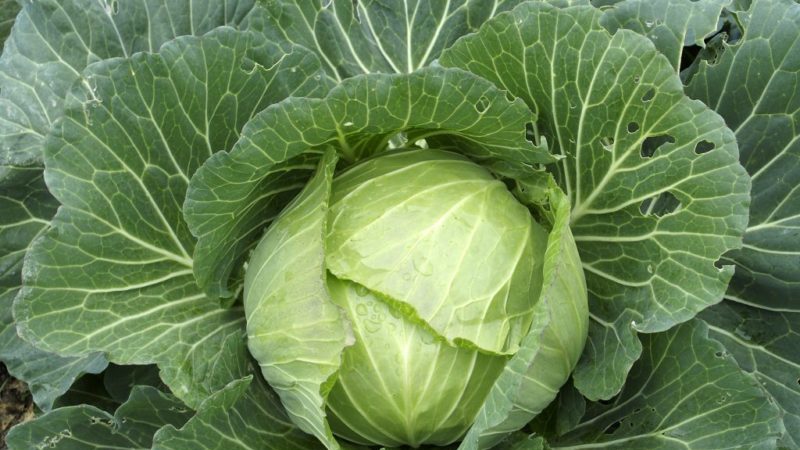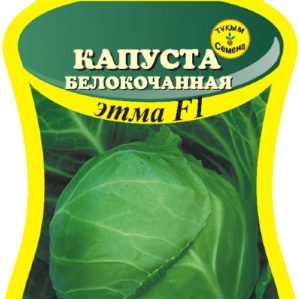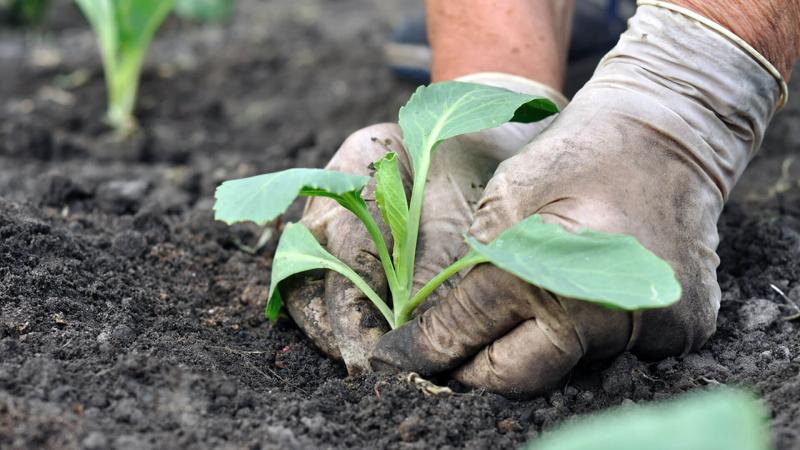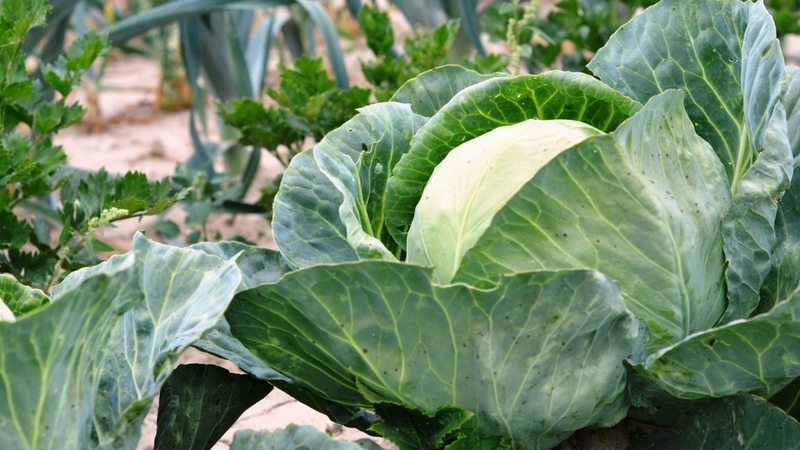An early ripe hybrid of Etma f1 cabbage with excellent taste
Etma F1 (Etma) is a hybrid of white cabbage, loved by many farmers due to its resistance to common diseases, early ripening and excellent taste.
The article will tell you about the intricacies of growing this popular culture, the advantages and disadvantages, taste and benefits of the fruit.
The content of the article
- Description of the hybrid
- Origin and development, history of breeding
- Chemical composition, trace elements and vitamins, useful properties
- Application features
- Ripening period and yield
- Resistance to disease and cold
- Characteristics, description of the appearance of leaves and head of cabbage, taste
- For which regions it is best suited and what is the exacting climate
- The main advantages and disadvantages of a hybrid
- Features of planting and growing
- Harvesting and storage
- What can be the difficulties in growing
- Advice and feedback from experienced gardeners
- Conclusion
Description of the hybrid
Etma F1 is a hybrid of white cabbage, bred in the Netherlands. It is successfully grown in open beds and in closed ground - in greenhouses, hotbeds, under cover of film or agrofibre.

Origin and development, history of breeding
Etma F1 is a Dutch breeding hybrid, bred by scientists at Rijk Zwaan.
Reference. Included in the State Register of Russia in 2002.
Chemical composition, trace elements and vitamins, useful properties
100 g of Etma cabbage contains 28 kcal, as well as:
- vitamin PP - 0.7 mg;
- vitamin K - 76 mcg;
- ascorbic acid - 45 mg;
- cobalt - 3 mcg;
- manganese - 0.17 mg;
- copper - 75 mcg;
- molybdenum - 10 mcg;
- calcium - 48 mg;
- magnesium - 16 mg;
- phosphorus - 31 mg;
- chlorine and sulfur - 37 mg each.
The use of cabbage prevents the development of atherosclerosis, improves the functioning of the gastrointestinal tract, and helps in the treatment of stomach and duodenal ulcers. The vegetable is useful in the fight against insomnia, diseases of the heart, spleen and kidneys, improves appetite, and has a diuretic effect.
Application features
The hybrid is characterized by its versatility. It is consumed fresh, used to prepare vegetable salads, fermented, salt and stew... Raw vegetables are healthier than cooked.
Ripening period and yield
This is a hybrid of early ripening - 75-115 days pass between the emergence of seedlings and the onset of technical maturity of the heads.
With proper care and adherence to planting rules, the yield is 261-426 c / ha (for the first harvest - 128-234 c / ha).
Resistance to disease and cold
The hybrid is resistant to fusarium and internal necrosis, but it can be affected by white rot, keel and black leg.
Subject to hardening seedlings cabbage can withstand temperatures as low as –8 ° C.
Characteristics, description of the appearance of leaves and head of cabbage, taste
The hybrid forms compact, medium-dense, rounded heads of cabbage, the average weight of which is 1-1.5 kg. The outer and inner stalks are short. Covering leaves are light green, covered with a weak or medium waxy bloom, rounded, flat, slightly bubbly. In the context of the heads of cabbage yellowish or white.
Cabbage is characterized by juiciness and sweet taste, practically devoid of bitterness.
For which regions it is best suited and what is the exacting climate
The hybrid is included in the State Register with a recommendation for growing in the Central and North-West regions. Early cabbage Etma does not have special requirements for the climate, so it is successfully cultivated in all areas.
Reference. Growing outdoors is recommended in areas with warm climates.
The main advantages and disadvantages of a hybrid
Advantages:
- early ripening;
- good transportability;
- resistance to diseases characteristic of the culture;
- lack of tendency to cracking;
- friendly formation of heads of cabbage;
- large yield of marketable products.
Etma F1 cabbage has practically no flaws. The only drawback is the short storage period of the crop.
What is the difference from other varieties and hybrids
Comparison of Etma F1 with other early maturing hybrids is presented in the table.
| Hybrid | Head shape | Head of cabbage weight, kg | Marketable yield, c / ha |
| Etma | Rounded | 1-1,5 | 261-426 |
| Angelina | 1,0-1,2 | 445-512 | |
| Zenith | 1,2-1,6 | 380-504 | |
| Cambria | 1,1-1,3 | 228-356 |
Features of planting and growing
The hybrid is suitable for growing in seedling and non-seedling methods. The first method is used more often - seedling growing protects young plants from recurrent frosts.
Preparing for landing
For planting, choose a place that is illuminated and protected from gusty winds and drafts.
In the fall, the site is cleared of plant residues, dug up and add compost, humus or manure.
2 weeks before transplanting seedlings, the soil is fertilized with a mixture of 1 tbsp. l. urea, 1 tbsp. l. superphosphate 1 tbsp. wood ash.
Important! A crop should not be grown in one place for more than two years in a row - this reduces productivity and increases the risk of developing diseases and pest attacks.
Seed preparation
If purchased seeds are processed by the manufacturer, no additional preparation is required. Otherwise, to improve germination, the seed is placed in warm (+ 40 ... + 50 ° C) water beforehand, for 15-20 minutes, and then for 2 minutes. dipped in the cold.
For sowing seeds, use a ready-made substrate or make it yourself, choosing one of the suitable options:
- equal parts of peat and sand;
- 75% peat, 20% turf and 5% sand;
- 45% humus, 50% turf, 5% sand.
Seed sowing algorithm:
- Put a layer of soil mixture with a height of 3-4 cm in a container for sowing.
- Sprinkle with "Alerin-B" and "Gamair".
- After 1-3 days, make 1 cm deep grooves in the substrate every 3 cm.
- Place seeds in them at a distance of 1-1.5 cm from each other.
- Sprinkle with a layer of soil 1.5-2 cm high.
- Place the container in a room with an air temperature of + 18… + 20 ° C, after the emergence of shoots, lower it to + 7… + 9 ° C.
Sowing is carried out 55-65 days before the intended transplantation of seedlings into the ground.
Seedling preparation
7-10 days after the emergence of shoots, a pick is carried out. For this, containers with a diameter of 6-8 cm are prepared in advance and the same soil mixture that was used when sowing seeds, but with the addition of double superphosphate and wood ash (1 and 2 tbsp. L. Per bucket of mixture, respectively). A nutrient substrate is poured into the container, and river sand is placed on top to minimize the risk of developing a black leg.
After picking, the plants are kept at a temperature of + 17 ... + 18 ° C for 2-3 days, then it is reduced to + 13 ... + 14 ° C during the day and + 10 ... + 12 ° C at night.
When 2 leaves appear on the seedlings, complex mineral fertilizers are applied.
15-20 days before transplanting seedlings into the ground, they begin to harden. For this, the plants are taken out every day, gradually increasing the time of their stay there from 15 minutes. up to 24 hours.
Reference. To avoid the need for picking, seeds are sown immediately in individual containers of 1-2 pcs.
How to make a seedless plant
In the case of seedless planting, the seed is sown directly into the prepared soil, deepening by 1.5-2 cm and observing a distance between the seeds of 5-6 cm. After that, the beds are sprinkled with nutritious soil and watered.
Ground requirements
Etma F1 prefers fertile, air and moisture permeable soil with neutral acidity.The best option is loam.
Predecessors
This hybrid is not planted after tomatoes, crucifers, radishes, turnips, beets. The best predecessors are carrots, garlic, cucumbers, potatoes, onions, legumes and grains.
Timing, scheme and landing rules

Seedlings are transplanted into the ground from late spring to mid-June... Plants should be strong, with a developed root system, 6-8 leaves and at least 15 cm in height.
In the prepared area, planting holes are dug at a distance of 30 cm from each other in the case of drip irrigation and 35 cm - without it. The distance between the rows in the first case is 50 cm, in the second - 45 cm. Planting density - 6-9 g per 1 m².
The plants are removed from the containers in which they grew and placed in the prepared recesses along with a lump of earth, deepening to the bottom leaf. The voids are filled with earth, lightly tamped and watered. After transplanting, the seedlings are covered with agrofibre.
Features of growing and nuances of care
The hybrid is unpretentious in care and needs to comply with standard agrotechnical requirements: regular watering, fertilizing, loosening the soil, hilling and preventing diseases and pests.

Watering mode
Within a month after transplanting seedlings into the ground, it is watered every 2 days, pouring 2-3 liters of water under the plant. After a month, watering is carried out once a week at the rate of 10-12 liters of warm (at least + 18 ° C) water per 1 m².
Council. The best way to irrigate is drip.
Loosening and hilling
After each watering or rain, the soil is loosened to a depth of 7 cm. This makes the top layer of the soil looser and improves its air and moisture permeability.
Simultaneously with loosening, weeding is carried out, removing weeds, which create shading and an environment favorable for diseases and pests.
Hilling 2 times per season: 20 days after transplanting and 10-12 days later. This stimulates lateral root growth and improves plant development. To do this, they rake the earth in the near-trunk zone and sprinkle it on the stem.
Top dressing
Fertilizers are applied 3-4 times per season:
- 14 days after transplanting seedlings - nitrogen-containing fertilizing (Agricola, Sudarushka, chicken droppings);
- after 10 days - mullein or a mixture of ammonium nitrate with superphosphate and potassium chloride in a 1: 2: 1 ratio;
- before the formation of heads - potassium-phosphorus fertilizers (wood ash);
- August - nitrophoska, diammofoska.
Measures to increase the yield
To increase the yield of cabbage, it is regularly fed using different types of fertilizers, including foliar fertilizers. It is also important not to neglect preventive plant treatments for diseases and pests.
Disease and pest control

Diseases and pests dangerous for Etma F1:
| Pest / disease | Signs | Treatment / prevention |
| Aphid | Leaves fade, become brittle, the area between the veins dries up, the plant becomes covered with yellow spots and dries up, a sticky dirty coating appears on the cabbage | Spraying plants with onion peel infusion |
| Medvedka | Due to damage to the roots, the plant rapidly withers and dies | To get rid of the pest, use poisonous baits "Thunder" or "Phenoxin plus" |
| Slugs | Small gnawed holes are visible on cabbage | The near-trunk circle is dug up and watered with "Aktofit".
To avoid the attack of slugs, sprinkle the aisles with chalk or crushed eggshell |
| Cruciferous flea | Ulcers appear on the plant, its tissues die off | To prevent the aisles, sprinkle with ash or tobacco dust, spray the plants with ash infusion |
| Cabbage leaf beetle | Leaves show holes and chewed edges | Biological treatment (Fitoverm, Bitoxibacillin) |
| Cabbage butterfly | Butterflies with white wings. Their caterpillars feed on fruits and shoots, devour tissue and leave only veins or large holes | To fight the butterfly, use the drugs "Aktofit", "Fitoverm", "Aktara".
For prevention, spray with valerian, salt, coniferous or soap-ash solutions |
| White rot | White spots and gray bloom appear on the heads of cabbage | The affected parts are removed, the plantings are treated with a solution of potassium permanganate and chalk, the beds are sprinkled with coal |
| Keela | The lower leaves wither, growths appear on them | They get rid of infected plants, plantings are treated with fungicides ("Vectra", "Rex", "Tilt") |
| Blackleg | Rotting leaves and stems is observed | Treatment with "Fundazol", "Planriz" |
Harvesting and storage
The crop of this hybrid is harvested by hand or mechanized, the yield of marketable products is 92-98%.
How and when to collect
Harvesting is carried out 45-50 days after planting seedlings in the ground, choosing a dry day for this. The heads are cut off with a sharp knife, leaving a stump 8-12 cm long.
Reference. After ripening, cabbage withstands on the root for a maximum of a week.
Storage features and keeping quality
The harvested crop is placed in wooden boxes and stored in a ventilated room at an air temperature of 0 ... + 5 ° C and a humidity of 90-95%.
The shelf life of Etma F1 is maximum 3 months. You can extend it by wrapping the heads of cabbage in paper or smearing them with clay.
What can be the difficulties in growing
Growing Etma cabbage, gardeners face the following problems:
- gray rot on the heads of cabbage during storage - the storage conditions of the crop are violated, the room is too warm and humid;
- plants affect keela - most often this disease develops when cabbage is grown in soil with high acidity;
- fungal infections are the result of watering plantings with cold water.
Advice and feedback from experienced gardeners
Experienced farmers recommend:
- use only warm water for irrigation - this minimizes the risk of developing fungal diseases;
- sprinkle the beds with wood ash or tobacco dust to protect them from slugs and insects;
- planting marigolds, dill, parsley in aisles - this scares off pests.
Gardeners speak positively about the hybrid.
Ivan, Voronezh: “I have been growing Etma cabbage for a long time. I like that the heads of cabbage ripen early and amicably. The cabbage is pleasant to taste - juicy and sweet. It is not stored for long, but I do not plant a lot, and we manage to eat it fresh. "
Constantine, Tula: “I don't see any flaws in this cabbage. I have been planting it for a long time, even selling it a little. The yield is stable, the care of the culture is not difficult, the heads of cabbage are beautiful and tasty. The only pity is that you cannot grow from your own seeds, but this is a drawback of all hybrids, not only that. "
Conclusion
Etma F1 is a cabbage hybrid, practically devoid of flaws. It has a stable immunity to diseases, forms beautiful and tasty heads of cabbage, is suitable for growing in open and closed ground by seedling and seedling methods, does not impose special requirements for care.